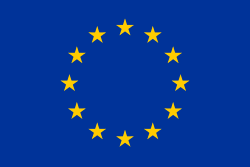Europeiska unionens grundläggande värden

Europeiska unionens grundläggande värden fastställs i artikel 2 i fördraget om Europeiska unionen och innefattar[1]
- respekt för människans värdighet,
- frihet,
- demokrati,
- jämlikhet,
- rättsstaten, och
- respekt för de mänskliga rättigheterna, inklusive rättigheter för personer som tillhör minoriteter.
Fördraget föreskriver att dessa värden ska ”vara gemensamma för medlemsstaterna i ett samhälle som kännetecknas av mångfald, icke-diskriminering, tolerans, rättvisa, solidaritet och principen om jämställdhet mellan kvinnor och män”.[2]
Varje europeiskt land som vill ansöka om medlemskap i Europeiska unionen måste respektera de grundläggande värdena och förbinda sig att främja dem.[3] En medlemsstat som allvarligt och ihållande åsidosätter värdena kan bli föremål för sanktioner av unionens institutioner genom ett artikel 7-förfarande.[4]
Se även
- Europeiska unionens fördrag
- Europeiska unionens stadga om de grundläggande rättigheterna
- Humanism
- Rättsstatens principer inom Europeiska unionen
- Värdegrund
Referenser
- ^ ”EU:s mål och värderingar”. Europa (webbportal). 31 mars 2020. https://europa.eu/european-union/about-eu/eu-in-brief_sv. Läst 6 maj 2021.
- ^ ”Artikel 2 i fördraget om Europeiska unionen”. EUT C 202, 7.6.2016, s. 17. EUR-Lex. https://eur-lex.europa.eu/legal-content/SV/TXT/PDF/?uri=OJ:C:2016:202:FULL.
- ^ ”Artikel 49 i fördraget om Europeiska unionen”. EUT C 202, 7.6.2016, s. 43. EUR-Lex. https://eur-lex.europa.eu/legal-content/SV/TXT/PDF/?uri=OJ:C:2016:202:FULL.
- ^ ”Artikel 7 i fördraget om Europeiska unionen”. EUT C 202, 7.6.2016, s. 19–20. EUR-Lex. https://eur-lex.europa.eu/legal-content/SV/TXT/PDF/?uri=OJ:C:2016:202:FULL.
| EU-portalen – temasidan för Europeiska unionen på svenskspråkiga Wikipedia. |
Media som används på denna webbplats
The Flag of Europe is the flag and emblem of the European Union (EU) and Council of Europe (CoE). It consists of a circle of 12 golden (yellow) stars on a blue background. It was created in 1955 by the CoE and adopted by the EU, then the European Communities, in the 1980s.
The CoE and EU are distinct in membership and nature. The CoE is a 47-member international organisation dealing with human rights and rule of law, while the EU is a quasi-federal union of 27 states focused on economic integration and political cooperation. Today, the flag is mostly associated with the latter.
It was the intention of the CoE that the flag should come to represent Europe as a whole, and since its adoption the membership of the CoE covers nearly the entire continent. This is why the EU adopted the same flag. The flag has been used to represent Europe in sporting events and as a pro-democracy banner outside the Union.